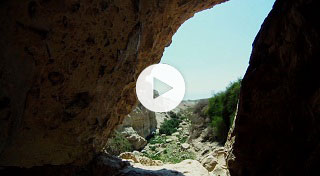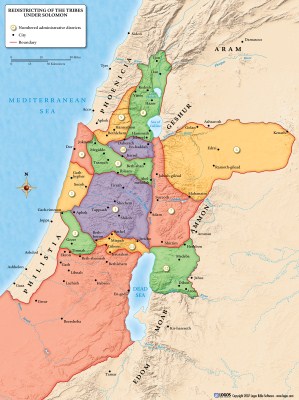1:1–4 The Song, likely meant to be sung aloud, represents the love between a man and a woman. It opens with words from a woman. The Song |
1:1 The Song of Songs The Hebrew word used here, shir, which opens Song of Songs, most often indicates a happy or joyful song (Psa 28:7; Prov 25:20; Isa 30:29).
most often indicates a happy or joyful song (Psa 28:7; Prov 25:20; Isa 30:29).
which is for Solomon The Hebrew preposition used here, le-, can mean “to,” “for,” “by,” or “about.” The relationship between the Song and Solomon is unclear. Solomon
and Solomon is unclear. Solomon may have been the author of the book, the book may have been written for or dedicated to him, or it could be in the tradition of Solomon (in his honor or as a critique of him; compare Song 8:11–12 and note).
may have been the author of the book, the book may have been written for or dedicated to him, or it could be in the tradition of Solomon (in his honor or as a critique of him; compare Song 8:11–12 and note).
1:2 May he kiss me The woman begins her song by expressing her desire for physical love. While kissing was used in greetings and as a sign of respect (Gen 29:13; 1 Sam 10:1), it was also used to express romantic love (Prov 7:13).
was used in greetings and as a sign of respect (Gen 29:13; 1 Sam 10:1), it was also used to express romantic love (Prov 7:13).
your love is better than wine The Hebrew word used here, dod, most likely indicates sexual love (Prov 7:18; Ezek 23:17). The woman describes her lover as more pleasing and intoxicating than wine.
1:3 perfumes Oils were used for beautification. Ancients mixed oil with fragrant flower blossoms or spices to make perfumed ointments (Esth 2:12).
your name is poured out perfume The Hebrew shemekha (“your name”) is very similar to the Hebrew word shemen (“oil”), which creates a poetic wordplay. “Name” here indicates the man’s reputation (Eccl 7:1).
young women The word almah indicates a young woman of marriageable age. See note on Isa 7:14.
love you In contrast to the earlier Hebrew word used for love (dod; Song 1:2), the Hebrew word used here, ahev, better describes general attraction or care. All of the young women desire the man.
1:4 Draw me after you The word mashakh can mean “to seize” or “carry off” (Psa 28:3). The woman longs for her lover to come for her, wishing he would take her away.
the king This line can be seen as a fulfillment of the woman’s wish from the beginning of the verse. Though the designation “king” may indicate literal royalty, it may be a term of endearment for the lover.
Let us be joyful and let us rejoice in you The second half of Song 1:4 is a summarizing refrain or chorus. It emphasizes that the man’s love (dod) is better than wine (20), and that the young women are correct to love (ahev) him (1:3). While the identity of the singers is uncertain, they are likely the “daughters of Jerusalem” from 1:5.
1:5 am black but beautiful In ancient Near Eastern culture, light skin was considered an indicator of beauty. Women in working-class families became darkened by the sun since they worked outside in the fields (1:6), so light skin may have been more desirable because dark skin often indicated a lower social class.
O maidens of Jerusalem The identity of the daughters of Jerusalem is disputed. They could be rivals of the woman—privileged city girls in contrast to the dark-skinned field laborer (1:6). However, no conflict between the daughters and the woman is apparent. Within the book, their words function as a chorus.
Kedar The Kedar—most likely nomadic shepherds (Isa 60:7; Jer 49:28–29)—were an Arabian tribe descended from Ishmael (Gen 25:13).
1:6 were angry The Hebrew word used here, charah, literally means “to become hot.” It may be a play on words; her brothers’ anger or heat caused her to be burned by the sun.
my own “vineyard A metaphor for physical appearance.
1:7 you whom my heart loves Indicates the woman’s deep desire for her beloved. See note on 3:1.
where do you pasture your flock The woman now addresses the man. She asks him where he is taking his flocks for their noon rest. She wants to meet with him, most likely for a sexual encounter.
one who is veiled The woman wants to know the man’s location to avoid having to search for him among other flocks. The reference to a veil probably indicates that by searching for him, she would have looked like a cult prostitute (see Deut 23:17–18; compare the story of Tamar in Gen 38:14–19).
1:8 If you do not know The man speaks for the first time. His response is both tender and playful. He compliments her, describing her as the most beautiful woman. He then teases her by not telling her where he is located, instead encouraging her to follow his flock’s tracks.
pasture your little lambs The speaker seems to advise the woman to disguise herself and her reasons for being out. In this way, she can still search for her lover without looking like a cult prostitute (compare note on Song 1:7).
1:9 a mare among the chariots of Pharaoh In the ancient Near East, only stallions were used to pull chariots. Releasing a mare among chariots would excite and distract the stallions. With this comparison, the man tells the woman that she is desirable to all men (1:3–4).
1:10 Your cheeks are beautiful with ornaments The woman’s jewelry enhances her beauty.
1:11 We will make As in 1:4, a chorus echoes the descriptions of 1:10. It is unclear if this is spoken by the daughters of Jerusalem or if it includes the man.
nard An expensive ointment extracted from a plant found in the Himalayan Mountains. A woman (identified as Mary the sister of Lazarus in John 12:3) used it to anoint Jesus (Mark 14:3–9).
1:13 a pouch of myrrh A fragrant gum used in anointing oil (Exod 30:23), as well as a perfume (Psa 45:8).
he spends the night between my breasts The Hebrew word used here, lin, means “to stay the night” (Gen 28:11). The woman describes a close physical intimacy between her and her beloved.
1:14 henna When crushed, henna blossoms produce a reddish dye used to color hair or skin. They are referred to here for their fragrant qualities.
En Gedi A fertile oasis located along the western shore of the Dead Sea.
located along the western shore of the Dead Sea.
1:15 your eyes are doves Since doves were not a common symbol of beauty (Hos 7:11), the reason for this comparison is unclear. The twofold statement of the woman’s beauty indicates it is a compliment. It may describe gentleness or softness.
1:16 couch is verdant The Hebrew word used here, ra'anan (meaning “leafy” or “luxuriant”), is meant to evoke an outdoor garden or forest location.
1:17 the beams of our house are cedar The woman is not describing a literal house; she poetically describes the outdoor location of their lovemaking.

|
About Faithlife Study BibleFaithlife Study Bible (FSB) is your guide to the ancient world of the Old and New Testaments, with study notes and articles that draw from a wide range of academic research. FSB helps you learn how to think about interpretation methods and issues so that you can gain a deeper understanding of the text. |
| Copyright |
Copyright 2012 Logos Bible Software. |
| Support Info | fsb |
 Loading…
Loading…



